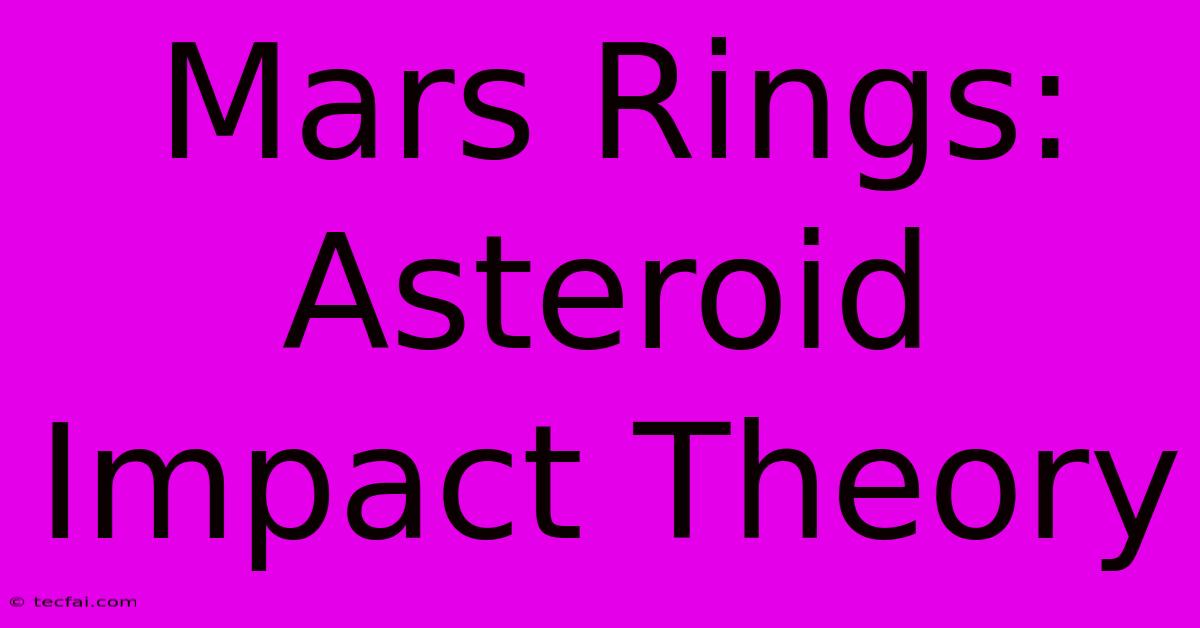Mars Rings: Asteroid Impact Theory

Discover more detailed and exciting information on our website. Click the link below to start your adventure: Visit Best Website tecfai.com. Don't miss out!
Table of Contents
Mars Rings: Asteroid Impact Theory – A Cosmic Collision's Aftermath
The idea of Mars possessing rings, much like Saturn's majestic icy circles, might seem fantastical. Yet, the prevailing scientific theory suggests that Mars did once boast a ring system, and its formation is intrinsically linked to a catastrophic asteroid impact. This theory, while still under investigation, provides a compelling explanation for the current Martian landscape and the potential future evolution of the Red Planet.
The Missing Martian Rings: A Tale of Disappearance
While we don't currently observe rings around Mars, evidence suggests they may have existed in the relatively recent past, geologically speaking. The absence of these rings, however, isn't a contradiction to the impact theory; rather, it's a crucial part of it. The theory posits that these rings were ephemeral, a temporary phenomenon born from a colossal collision and destined to disappear.
The Phobos Puzzle: A Crucial Piece of the Evidence
One key piece of evidence supporting the asteroid impact theory is the Martian moon Phobos. This irregularly shaped moon is unusually close to Mars and is spiraling inwards, slowly but surely. Scientists believe that Phobos is the remnant of a much larger object that was shattered by an asteroid collision millions of years ago. The debris from this collision formed a ring system around Mars.
The Asteroid Impact: A Violent Genesis
The theory proposes that a large asteroid, potentially several hundred kilometers in diameter, struck Mars. This impact wouldn't just have created a massive crater (which we might still see evidence of); it would have ejected a vast amount of Martian material into orbit. This ejected debris—rock, dust, and ice—would then coalesce to form a ring system. The size and composition of this ring system would depend on the size and angle of the impacting asteroid, as well as the composition of the Martian crust.
Simulating the Impact: Computer Models and Their Predictions
Scientists use sophisticated computer models to simulate such impacts. These models help them predict the amount of material ejected, the distribution of this material in orbit, and the subsequent evolution of any resulting ring system. The simulations offer strong support for the idea that an impact of sufficient scale could create a temporary ring structure around Mars.
The Rings' Demise: From Glory to Oblivion
But what happened to these rings? The theory suggests several factors contributing to their eventual disappearance. Firstly, the gravitational influence of Mars itself would gradually pull the ring material inwards. Some of this material would eventually accrete to form moons like Phobos (and potentially Deimos, although its origin is less certain). Other material would spiral into the Martian atmosphere and burn up, creating spectacular meteor showers.
The Role of Gravity: A Slow but Inevitable Decline
The interplay of gravity is crucial here. The smaller particles in the ring would experience more atmospheric drag, leading to their quicker demise. Larger particles would take longer to decay, but eventually, the gravitational forces of Mars would overcome their orbital momentum, leading to their fall.
Future Research and Implications
The asteroid impact theory remains a topic of ongoing research. Further analysis of Martian meteorites, sophisticated computer simulations, and future missions to Mars, particularly those involving sample returns from Phobos, are crucial for solidifying this theory. Understanding the formation and evolution of Martian rings provides valuable insights into the early history of the solar system and the processes that shape planetary bodies.
Keywords: Mars rings, asteroid impact, Phobos, Martian moon, Deimos, planetary rings, solar system formation, Martian geology, impact simulation, space exploration, Red Planet.

Thank you for visiting our website wich cover about Mars Rings: Asteroid Impact Theory. We hope the information provided has been useful to you. Feel free to contact us if you have any questions or need further assistance. See you next time and dont miss to bookmark.
Featured Posts
-
Uk Bank Holidays 2025 Extra Day Confirmed
Nov 26, 2024
-
Face A Grandmaster Hungary Hotel
Nov 26, 2024
-
Court Delays Menendez Brothers Resentencing
Nov 26, 2024
-
Assisted Dying Two Thirds In Favor
Nov 26, 2024
-
U Conn Loses Memphis Wins In Maui
Nov 26, 2024
